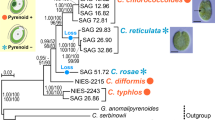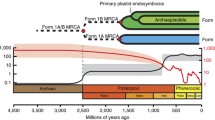Abstract
The rbcS gene coding for the small subunit of ribulose-1,5-bisphosphate carboxylase/oxygenase (Rubisco) of the brown alga Pylaiella littoralis is located within the plastid genome and is transcribed as a single polycistronic mRNA with the gene for the large subunit of Rubisco, rbcL. The structure of the Rubisco operon from P. littoralis was determined. Molecular phylogenies for rbcS and rbcL with a wide range of prokaryotes and eukaryotes were constructed which are congruent with recent evidence for polyphyletic plastid origins. Both rbcL and rbcS of the β-purple bacterium Alcaligenes eutrophus clearly cluster with the rhodophyte and chromophyte proteins. The data suggest that the Rubisco operons of red algal and chromophytic plastids derive from β-purple eubacterial antecedents, rather than the cyanobacterial lineage of eubacteria from which other of their genes derive. This implies a lateral transfer of Rubisco genes from β-purple eubacterial ancestors to the cyanobacterial ancestor of rhodophyte and chromophyte plastids.
Similar content being viewed by others
References
Anderson, K, Caton, J: Sequence analysis of the Alcaligenes eutrophus chromosomally encoded ribulose bisphosphate carboxylase large and small subunit genes and their gene product. J Bact 169: 4547–4558 (1987).
Assali, NE, Mache, R, Loiseaux-de Goër, S: Evidence for a composite phylogenetic origin of the plastid genome of the brown alga Pylaiella littoralis (L.) Kjellm. Plant Mol Biol 15: 307–315 (1990).
Bhattacharya, D, Elwood, HJ, Goff, L, Sogin, ML: Phylogeny of Gracilaria lemaneiformis (Rhodophyta). J Phycol 26: 181–186 (1990).
Boczar, BA, Delaney, TP, Cattolico, RA: Gene for the ribulose-1,5-bisphosphate carboxylase small subunit protein of the marine alga Olisthodiscus luteus is similar to that of a chemoautoptrophic bacterium. Proc Natl Acad Sci USA 86: 4996–4999 (1989).
Chan, RL, Keller, M, Canaday, S, Weil, JH, Imbault, P: Eight small subunits of Euglena ribulose 1.5 bisphosphate carboxylase/oxygenase are translated from a large mRNA as a polyprotein. Embo J 9: 333–338 (1990).
Dalmon, J, Loiseaux, S, Bazetoux, S: Heterogeneity of plastid DNA of two species of brown algae. Plant Sci Lett 29: 243–253 (1983).
Devereux, J, Heaberli, P, Smithies, O: A comprehensive set of sequence analysis programs for the VAX. Nucl Acids Res 12: 387–395 (1984).
Dickerson, R: The structure of cytochrome c and the rates of molecular evolution. J Mol Evol 1: 26–45 (1971).
Douglas, SE, Durnford, DG: The small subunit of ribulose-1,5-bisphosphate carboxylase is plastid-encoded in the chlorophyll c-containing alga Cryptomonas F. Plant Mol Biol 13: 13–20 (1989).
Douglas, SE, Durnford, DG, Morden, CW: Nucleotide sequence of the gene for the large subunit of ribulose-1,5 bisphosphate carboxylase/oxygenase from Cryptomonas F: evidence supporting the polyphyletic origin of plastids. J Phycol 26: 500–508 (1990).
Felsenstein, J: Evolutionary trees from DNA sequences: A maximum likelihood approach. J Mol Evol 17: 368–376 (1981).
Gibbs, SP: The evolution of algal chloroplasts. In: Weissner, W, Robinson, DG, Starr, RC (eds) Experimental Phycology I, pp. 145–157, Springer-Verlag, Berlin (1990).
Gibson, JL, Tabita, FR: Different molecular forms of ribulose-1,5-bisphosphate from Rhodopseudomonas sphaeroides. J Biol Chem 252: 943–949 (1977).
Glover, HE: Ribulose bisphosphate carboxylase/oxygenase in marine organisms. Int Rev Cytol 115: 67–138 (1988).
Goldschmidt-Clermont, M, Rahire, M: Sequence, evolution and differential expression of the two genes encoding variant small subunits of ribulose bisphosphate carboxylase/oxygenase in Chlamydomonas reinhardtii. J Mol Biol 191: 421–432 (1986).
Gray, MW: The bacterial ancestry of plastids and mitochondria. Bioscience 33: 693–699 (1983).
Guoy, M, Li, WH: Phylogenetic analysis based on rRNA sequences supports the archaebacterial rather than the eocyte tree. Nature 339: 145–147 (1989).
Gunderson, H, Elwood, H, Ingold, A, Kindle, K, Sogin, ML: Phylogenetic relationships between chlorophytes, chrysophytes and oomycetes. Proc Natl Acad Sci USA 84: 5823–5827 (1987).
Hori, H, Osawa, S: Origin and evolution of organisms as deduced from 5S Ribosomal RNA sequences. Mol Biol Evol 4: 445–472 (1987).
Jin, L, Nei, M: Limitations of the evolutionary parsimony method of phylogenetic analysis. Mol Biol Evol 7: 82–102 (1990).
Keen, JN, Pappin, DJC, Evans, LV: Amino acid sequence analysis of the small subunit of ribulose bisphosphate carboxylase from Fucus (Phaeophyceae). J Phycol 24: 324–327 (1988).
Kostrzewa, M, Valentin, K, Maid, U, Radetzky, R, Zetsche, K: Structure of the rubisco-operon from the multicellular red alga Antithamnion spec. Curr Genet 18: 465–469 (1990).
Lewin, RA, Gibbs, SP: Algae of uncertain taxonomic position: introduction and bibliography. In: Rosowski, JR, Parker, BC (eds) Selected Papers in Phycology II, pp. 659–662, PSA, USA (1990).
Ludwig, W, Weizenegger, M, Betzl, D, Leidel, E, Lenz, T, Ludvigsen, A, Möllenhoff, D, Wenzig, P, Schleifer, KH: Complete nucleotide sequences of seven eubacterial genes coding for the elongation factor Tu: functional structural and phylogenetic evaluations. Arch Microbiol 153: 241–247 (1990).
Mazur, BJ, Chui, CF: Sequence of a genomic DNA clone for the small subunit of ribulose bisphosphate carboxylase/oxygenase from tobacco. Nucl Acids Res 13: 2373–2386 (1985).
Miziorko, HM, Lorimer, GH: Ribulose-1,5-bisphosphate carboxylase/oxygenase. Ann Rev Biochem 52: 507–535 (1983).
Nierzwicki-Bauer, SA, Curtis, SE, Haselkorn, R: Cotranscription of genes encoding the small and large subunits of ribulose-1,5-bisphosphate carboxylase in the cyanobacterium Anabaena 7120. Proc Natl Acad Sci USA 81: 5961–5965 (1984).
Palmer JD: Evolution of chloroplast and mitochondrial DNA in plants and algae. In: McIntyre RJ (ed) Monographs in Evolutionary Biology: Molecular Evolutionary Genetics, pp. 131–240. Plenum Press, New York.
Palmer JD, Baldauf SL, Calie PJ, de Pamphilis CW: Chloroplast gene instability and transfer to the nucleus. In: Clegg M, O'Brien S (eds) Molecular Evolution, vol 122, pp. 1–10. Alan R. Liss, New York.
Reith, M, Cattolico, RA: Inverted repeat of Olisthodiscus luteus chloroplast DNA contains genes for both subunits of ribulose-1,5-bisphosphate carboxylase and the 32000 dalton QB protein: Phylogenetic implications. Proc Natl Acad Sci USA 83: 8599–8603 (1986).
Saitou, N, Imanishi, T: Relative efficiencies of the Fitch Margoliash, Maximum-Parsimony, maximum-likelihood, minimum-evolution and neighbor-joining methods of phylogenetic tree construction in obtaining the correct tree. Mol Biol Evol 6: 514–525 (1989).
Saitou, N, Nei, M: The neighbor joining method: A new method for reconstructing phylogenetic trees. Mol Biol Evol 4: 406–425 (1987).
Shinozaki, K, Sugiura, M: The gene for the small subunit of ribulose-1,5-bisphosphate carboxylase/oxygenase is located close to the gene for the large subunit in cyanobacterium Anacystis nidulans 6301. Nucl Acids Res 11: 6956–6964 (1983).
Sogin, ML, Gunderson, JH: Structural diversity of Eukaryotic small subunit ribosomal RNAs. Evolutionary implications. Ann NY Acad Sci 503: 125–139 (1987).
Sogin, ML, Gunderson, JH, Elwood, HJ, Alonso, RA, Peattie, DA: Phylogenetic meaning of the kindom concept, an unusual ribosomal RNA from Giardia lamblia. Science 243: 75–77 (1989).
Sourdis, J, Nei, M: Relative efficiencies of the maximum parsimony and distance matrix methods in obtaining the correct phylogenetic tree. Mol Biol Evol 5: 298–311 (1988).
Starnes, SM, Lambert, DH, Maxwell, ES, Stevens, SE, Jr, Portis, RD, Shively, JM: Cotranscription of the large and small subunit genes of ribulose-1,5-bisphosphate carboxylase/oxygenase in Cyanophora paradoxa. FEMS Microbial Lett 28: 165–169 (1985).
Stein, JL, Haygood, M, Felbeck, H: Nucleotide sequence and expression of a deep-sea ribulose-1,5-bisphosphate carboxylase gene cloned from a chemoautotrophic bacterial endosymbiont. Proc Natl Acad Sci USA 87: 8850–8854 (1990).
Stern, DB, Jones, H, Gruissem, W: Function of plastid mRNA 3′ inverted repeats. RNA stabilization and genespecific protein binding. J Biol Chem 264: 18742–18750 (1989).
Tabita, FR, McFadden, BA: D-Ribulose-1,5-diphosphate carboxylase from Rhodospirullum rubrum II: Quaternary structure, composition, catalytic and immunological properties. J Mol Chem 249: 3459–3464 (1974).
Valentin, K, Zetshe, K: The genes of both subunits of ribulose-1,5-bisphosphate carboxylase constitute an operon on the plastome of a red alga. Curr Genet 16: 203–209 (1989).
Valentin, K, Zetsche, K: Rubisco genes indicate a close phylogenetic relation between the plastids of Chromophyta and Rhodophyta. Plant Mol Biol 15: 575–584 (1990).
Valentin, K, Zetsche, K: Structure of the Rubisco operon from the unicellular red alga Cyanidium caldarium: Evidence for a polyphyletic origin of the plastids. Mol Gen Genet 222: 425–430 (1990).
Valentin, K, Zetsche, K: Nucleotide sequence of the gene for the large subunit of Rubisco from Cyanophora paradoxa. Phylogenetic implications. Curr Genet 18: 199–202 (1990).
Viale, AM, Kobayashi, H, Akazawa, T: Expressed genes for plant-type ribulose 1,5 bisphosphate carboxylase/oxygenase in the photosynthetic bacterium Chromatium vinosum, which possesses two complete sets of the genes. J Bact 171: 2391–2400 (1989).
Whatley, JM, Whatley, FR: Chloroplast evolution. New Phytol 87: 233–247 (1981).
Woese, CR: Bacterial evolution. Microbiol Rev 51: 221–270 (1987).
Wolter, FP, Fritz, CC, Willmitzel, L, Schell, J, Schreier, P: rbcS genes in Solanum tuberosum: Conservation of transit peptide and exon shuffing during evolution. Proc Natl Acad Sci USA 85: 846–850 (1988).
Author information
Authors and Affiliations
Rights and permissions
About this article
Cite this article
Assali, NE., Martin, W.F., Sommerville, C.C. et al. Evolution of the Rubisco operon from prokaryotes to algae: Structure and analysis of the rbcS gene of the brown alga Pylaiella littoralis . Plant Mol Biol 17, 853–863 (1991). https://doi.org/10.1007/BF00037066
Received:
Accepted:
Issue Date:
DOI: https://doi.org/10.1007/BF00037066




